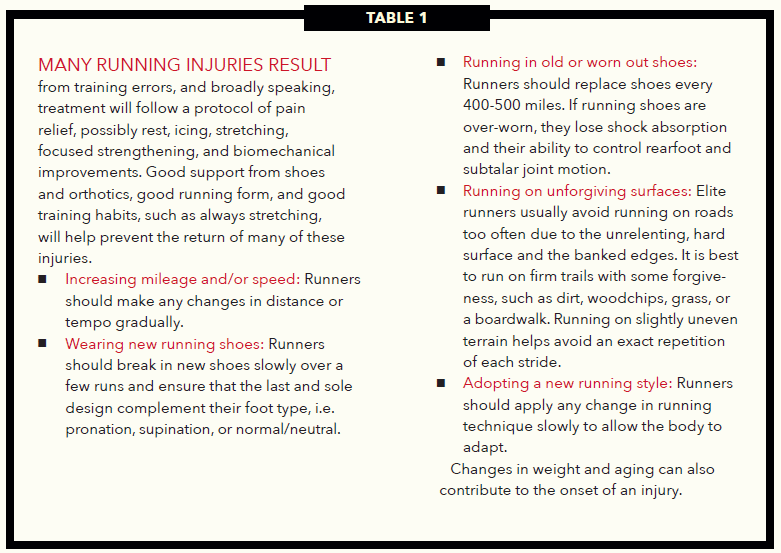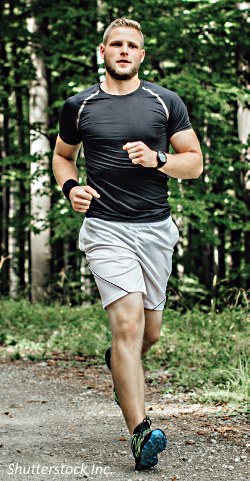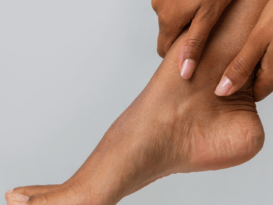Injuries, Orthotics, and Shoes
A previous article, “The Biomechanics of Running” (The O&P EDGE, March 2017), examined some of the unique aspects of the running cycle. Because running is a popular and widespread activity, it is important to be familiar with the distinct biomechanics and challenges that runners and other athletes face. This article looks at more ways in which running is different from walking and considers general guidelines regarding injuries, orthotics, and shoes.
Running Biomechanics

Running begins when the foot is in stance for less than 50 percent of the gait cycle. Put another way, runners only ever have one foot on the ground and that foot mitigates the entire burden of the ground reaction forces for the duration of stance. Depending on the runner’s speed, the average ground reaction force increases 50-70 percent, and the maximum impact peak can be two-and-a-half to three times his or her body weight. Compounding the issue, as runners spend less time in stance, cycle time is shortened, and if they are logging mileage, the total number of steps is high. A runner’s foot placement is closer to the midline of the body, and with a narrower base of support, the leg angle changes. The resulting increase in tibial varum may require additional pronation of the foot. Over longer distances, fatigue is also a consideration since muscle function may change. This accumulation of higher forces and frequency can cause injury, and under such conditions, even slight biomechanical abnormalities can create problems.
Originally it was believed that most running injuries were the result of high-impact forces, particularly those generated at heel strike. But slowly the thinking has changed as it has become clearer that many injuries occur due to the forces being dissipated and generated throughout the entire stance period. During the energy absorption phase, from initial contact to mid-stance, the transfer is from distal to proximal, up the kinetic chain. Movements across the subtalar joint, ankle, and knee, and the related muscle and tendon stretching, allow for energy transfer and the eccentric loading of muscles. The impact of initial contact is not just at the heel: the effect is borne along the entire leg and occurs over a longer period. This sequence is then reversed in the second half of stance when muscles concentrically contract, providing propulsion.
Despite a considerable amount of work on shoe designs and running surfaces in the 1970s and 1980s to reduce impact forces, there was little change in the rate of running injuries. Studies of injury types and prevalence show more proximal tissues are frequently involved. While runners may often present with plantar fasciitis and Achilles tendinopathy, they also develop knee pain, iliotibial band syndrome, medial tibial stress syndrome, and stress fractures, as well as hip and lower back pain. It appears that these injuries result from stresses applied throughout the stance phase of running and not just from impact. Accordingly, treatment extends beyond shock attenuation. For example, a mild, unrecognized leg length discrepancy of one-quarter to one-half inch may be a source of injury to a runner as he or she increases workout intensity. Likewise, other slight anomalies in muscle strength, functional length, or joint range of motion (ROM) provide asymmetries that may become problematic under repetitive stress.
Injuries
Chronic injuries, which account for most running injuries, develop over time and can be long lasting or constantly recurring. Many chronic exercise injuries have mild symptoms and low-grade pain and, consequently, are often ignored or overlooked for months or years. Ignoring these signs can lead to a persistent injury that is difficult to heal and that can eventually lead to breakdown.
When experienced runners develop a chronic injury, it is necessary to investigate possible changes to their regimen. Stephen Pribut, DPM, a member of the Runner’s World advisory board, cautions against the “terrible toos.”1,2 These are common mistakes linked to over-training: too much, too soon, too fast, too often, and with too little rest. In light of this, training considerations become important when evaluating and treating a patient (Table 1).


Foot Orthotics
Although the exact mechanisms of foot orthotics’ efficacy are still being researched, there is abundant evidence of their effectiveness in treating running injuries. Standard Root Theory prescribes functional foot orthotics with an emphasis on controlling forefoot to rearfoot position. This approach is valid in certain circumstances, especially when poor rearfoot control is considered the primary pain etiology. However, in running, heel strike can be 10 percent or less of overall stance. Even after heel lift occurs, it remains important to control the foot. The peak and duration of the ground reaction force is larger in mid-stance at the transition from absorption to generation, as the body accelerates for propulsion and float.
Under normal circumstances, pronation will reach a maximum at around 40 percent of the stance phase. In runners with excessive pronation, this will be delayed. Accordingly, many practitioners advocate midfoot and forefoot control in sports orthotics. One measure is navicular drop, or the relative change in the arch’s height. If the foot remains everted for too long, and external rotation of the tibia is delayed, it strains multiple joints and tissues including the midtarsal joint, plantar fascia, Achilles tendon, posterior tibial tendon, and structures around the knee. To address this, well-conforming orthotics can be constructed from semi-rigid thermoplastics, neoprenes, or other resilient foams and covered with cushioning materials such as Spenco or EVAs.
It is also important to completely evaluate forefoot function, record areas of callusing, and verify ROM, especially at the first metatarsal phalangeal joint. When designing orthotics for athletes, forefoot posting should extend to the sulcus for maximum effect. Longer and wider posts have a greater surface area to disperse forces through push-off. For example, a functional hallux limitus resulting from a plantarflexed first metatarsal can be addressed with a reverse Morton’s extension plus extended sulcus posting for the second through fifth metatarsals. By altering the timing and duration of pronation, preventing end ROM, and enhancing the alignment of the foot in relation to the leg, injuries can be successfully addressed or avoided.
Shoes
Good running shoes must incorporate several characteristics: attenuation of shock at heel strike, rearfoot motion control, and stance phase and forefoot stability with allowance for metatarsal flexion in preparation for propulsion. Biomechanics research fostered a new understanding that chronic running injuries are due to additional factors beyond initial contact shock and excessive pronation. Studies show that the best predictors of movement related injuries are sport-specific exposure, time, and previous injuries.
We have learned that the human locomotor system itself attenuates the effects of impact: the moving skeleton is not a simple mass whose vibrations should be dampened through cushioning. The body in motion responds to cushioning, but experiments by Benno M. Nigg, Dr.sc.nat., Dr.h.c.Mult., at the Human Performance Lab at the University of Calgary, Canada, indicate that during running, soft-tissue vibrations are short and heavily damped independent of the shoe-surface combination. He labelled this phenomenon and the changes in muscle activity “muscle tuning effects.”3 The muscle tuning paradigm can be summarized as follows. Impact force provides a signal that is sensed by the central nervous system, which in turn responds by adjusting and activating corresponding muscle groups. Tuning occurs to minimize soft-tissue vibrations. These effects are subject-specific and depend on the characteristics of soft-tissue compartments. It appears that the locomotor system minimizes the vibration of soft-tissue compartments automatically. Paradoxically, too much cushioning from a shoe or orthotic may inhibit this natural response.
Good shoe design balances the competing demands for protection, cushioning, stability, and motion. It seems there is no best shoe for all runners, but there is likely a right shoe for each runner. This is validated in experience as shoe design continues to cycle through trends from minimalist to maximalist, and from gel cushions to barefoot. More likely, within the wide range of options, there are specific features suitable to an individual’s biomechanics and preferences.
Compared with walking, running is a complex activity with higher forces and step rates. Slight anomalies in muscle or joint functions can potentially cause injuries. The choices for running style, orthotics, and shoes should be tailored to each individual. The patient’s experience is more important than any prevailing theory. Careful consideration of a runner’s biomechanics and the proper selection of shoes and orthotics can be effective in preventing and treating injuries.
References
1. Pribut, S. 2013. The top five running injuries seen in the office—Part 1. Podiatry Management April/May:187-96.http://www.podiatrym.com/cme/CME413%20(1).pdf.
2. Pribut, S. 2013. The top five running injuries seen in the office—Part 2. Podiatry Management June/July:181-88. https://www.podiatrym.com/cme/CME613.pdf.
3. Nigg, B. 2010. Biomechanics of Sport Shoes. Calgary.




















